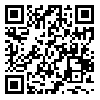قابل توجه نویسندگان محترم، مقالاتی که از تاریخ 1404/07/13 برای نشریه ارسال می شوند، شامل پرداخت هزینه بررسی نخواهند شد.
Volume 7, Issue 1 (Semi-Annual 2023)
JIC 2023, 7(1): 101-115 |
Back to browse issues page
Download citation:
BibTeX | RIS | EndNote | Medlars | ProCite | Reference Manager | RefWorks
Send citation to:



BibTeX | RIS | EndNote | Medlars | ProCite | Reference Manager | RefWorks
Send citation to:
Fatemeh Khaneh Zarrin F, sheikhi A. (2023). Analyzing the technical and artistic features of qalamzani of Iran in contemporary Period. JIC. 7(1), 101-115. doi:10.52547/jic.7.1.101
URL: http://jih-tabriziau.ir/article-1-131-en.html
URL: http://jih-tabriziau.ir/article-1-131-en.html
1- Master of handicraft, Department of applied Art, University of Art, Tehran. Iran
2- Associate Professor,Department of applied arts, University of Art, Tehran. Iran ,a.sheikhi@art.ac.ir
2- Associate Professor,Department of applied arts, University of Art, Tehran. Iran ,
Abstract: (2319 Views)
Familiarity of Iranians with copper metal and its smelting industry dates back to at least the fifth millennium BC. Metal that has been used in various historical periods from ancient times to the present to make various tools. The formability of this metal has revolutionized the history of human civilization and has multiplied its use. In addition to the manufacture of war tools and industrial tools, a large number of metal artifacts have survived throughout Iran's history. Some are related to copper metal or its alloy. In addition to copper, access to other metals such as silver and gold also led to the presentation of handicrafts of these metals for Iranian art. Many researchers have tried to introduce historical works in which scientists such as Arthur Pope, Robert Dyson, R.W Frey and Mohammad Taghi Ehsani are seen. What is quite clear is the admirable skill of the Iranians from these metals and the making of precious cultural relics that have been left for us. However, the direct and systematic introduction and study of the technical and artistic features of these works have not received much attention, and on the other hand, they end the history of metalworking in the Qajar period. But the continuity of this art has not stopped moving in the contemporary period, but has given it a special dynamism and meaning. What distinguishes this article in the first stage is the typology of techniques and methods of metallurgy in the historical period of Iran, which after many studies and studies have been classified into six groups. Half reliefs, reliefs, sculpture, meatballs, lattice and sculpture have been the result of this collection. The second issue is the position of Iranian metalworking art in the contemporary period. The cities of Isfahan, Borjard, Tehran, Shiraz, Tabas, Kerman, Kermanshah, Mashhad and Yazd were studied through surveys and field interviews. In these cities, the history of metalworking, design and role, productions, creativity and innovation, and the method of performing the art of metalworking have been researched and researched by the required artists. Certainly what adds to the scientific value of the work is the comparison of these elements in different cities. The research is basic in terms of purpose and descriptive-analytical in terms of method and nature. The method of collecting library information is specifically based on field data. The most important and characteristic features in each city are; Use a variety of steel rods hachure and Without hachure and metal on metal movement in Isfahan, The use of Warsaw metal in Boroujerd, motifs or traditional Iranian motifs in a new format in Tehran, the use of indigenous and symbolic motifs in Tabas engraving, Stamping in Kerman, designs of historical monuments in Kermanshah, gilding on other metals and gilding on stone, using three metals gold, silver and copper with different applications and competition of these three metals and gold products with native designs of Yazd, all of the features of engraving is in every city.
Keywords:
Keywords:
Type of Study: Original Research |
Subject:
2
Received: 2021/10/17 | Accepted: 2023/10/8 | Published: 2023/12/20
Received: 2021/10/17 | Accepted: 2023/10/8 | Published: 2023/12/20
Send email to the article author
| Rights and permissions | |
 |
This work is licensed under a Creative Commons Attribution-NonCommercial 4.0 International License. |






 tabriziau.ac.ir
tabriziau.ac.ir